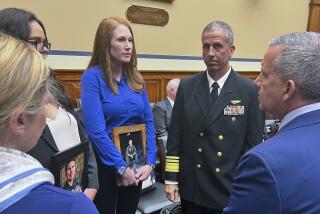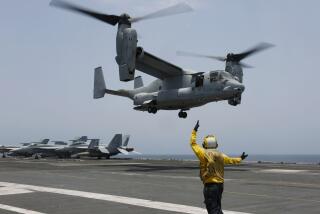Congressional Task Force to Study Harrier Jet Safety
- Share via
WASHINGTON — Despite assertions by the Marine Corps that its crash-plagued AV-8B Harrier attack jet is safe, House Armed Services Chairman Duncan Hunter (R-El Cajon) said Wednesday that he would create a task force to investigate a spate of recent accidents.
Hunter made his remarks at a committee hearing on escalating military aviation accidents.
Even though five Harriers crashed last year, Brig. Gen. Samuel T. Helland, the Marines’ assistant aviation chief, testified that the plane is a “supportable aircraft” that has “done superbly” in combat in Afghanistan and Iraq. Nonetheless, Hunter said he would appoint Rep. Howard P. “Buck” McKeon (R-Santa Clarita) to lead the task force that will assess the Harrier’s persistent safety problems.
The goal, Hunter said in an interview, will be to “see if there are facts that we can move on now that will help us to make the aircraft safe.”
The Harrier has long been the military’s most dangerous plane. Forty-five Marines have died in 148 noncombat accidents in the 32-year history of the single-seat jet. More than one-third of the fleet has been destroyed in crashes.
But its increased accident tally reflects a broader trend. The rate of serious, or Class A, accidents for all military aircraft jumped by about one-third in 2002 and 2003, to about two per 100,000 flight hours. A Class A accident is one that results in death or permanent injury or causes damage of more than $1 million.
In the Air Force alone, accidents in the last decade killed more than 300 aviators, destroyed more than 250 aircraft and cost $11 billion, said Maj. Gen. Kenneth W. Hess, the commander of the Air Force’s Safety Center. “These aviation accidents could have been prevented,” he said.
Hess and his Navy and Army counterparts told Armed Services Committee members that human factors -- mistakes by pilots, mechanics and aircrew -- cause the vast majority of accidents. Such errors contributed to 83% of the Navy’s serious accidents, while equipment or material failure contributed to 36%, said Rear Adm. Richard E. Brooks, the Naval Safety Center commander. Some accidents have multiple causes.
The demands of training and combat from U.S. involvement in the Balkans, Afghanistan and Iraq have taken a safety toll, Hess said. He cited the loss of helicopters operating under challenging conditions in the mountains of Afghanistan.
In contrast, the safety chiefs agreed, the aging of the military fleets does not pose a significant safety concern. Christopher Bolkcom, a military aviation analyst with the Congressional Research Service, testified that any correlation between aircraft age and safety “is unproven.” Rather, he said, “leadership is the single most important factor in increasing safety.” He noted that the number of staff with expertise and responsibility for aviation safety in the office of the Secretary of Defense had been cut in recent years from eight to none.
Defense Secretary Donald H. Rumsfeld challenged the services last year to reduce by half in the next two years the number and rate of accidents.
The military safety chiefs said Wednesday that the services were using more sophisticated simulators, stressing coordination within flight crews and pursuing technological improvements. These include cockpit devices to alert pilots to impending collisions and flight data recorders to detect potential problems before they cause a crash. Hunter suggested the military is moving too slowly to fully install such safety devices, which are standard in commercial airliners.
Rep. Ike Skelton (D-Mo.) asked Helland why the Marines’ major accident rate was twice that of other services. Helland responded that the Marine Corps flies predominantly combat aircraft, not transports. “Most of our flight time is done in a very aggressive and harsh environment,” he said.
At one point, Helland told Hunter that the Marines greatly improved the Harrier’s safety following the infusion of $175 million for fixes and upgrades and an extended grounding in 2000.
He then asserted that the AV-8B’s accident rate has, “in fact, been on the decline the whole time.”
Hunter challenged Helland’s statement. Naval Safety Center records show the AV-8B’s accident rate has vacillated but has not declined for any extended period since its inception in the mid-1980s. Its Class A accident rate in 2003 was 11.05 per 100,000 hours -- more than five times the average rate for all military aircraft. The AV-8B losses in 2003 totaled $154 million.
The causes of the five 2003 crashes remain under investigation. Helland said one involved “some sort of an anomaly in the aircraft”; in another, the engine may have been damaged by a foreign object. A third Harrier, he said, ran off the tarmac in Afghanistan in a strong crosswind. He said a pilot was doing combat maneuvers after having spent only 69 hours flying the AV-8B, suggesting “perhaps more flight time would have helped.”
Lack of sufficient flight hours has been a chronic complaint of Harrier pilots. Helland said AV-8B pilots have flown an average of 12.2 hours a month in the current fiscal year, within the target range of 12 to 15 hours for all Marine pilots. Because of the jet’s complexity, the recommended figure for Harrier pilots has been 15 to 20 hours of flying time per month.
Harriers flew 1,686 missions in Afghanistan, 58% of them at night, and 2,186 missions in Iraq, Helland said. None were shot down. One crashed in Afghanistan and one in the Persian Gulf.
The AV-8B is scheduled to fly for more than another decade until its successor, the Marines’ version of the Joint Strike Fighter, becomes available. The AV-8B production line was closed last year.
When asked in an interview whether the Marines were confident they would keep enough Harriers flying until the Joint Strike Fighter arrives, Helland said, “It’s something that we’re going to have to take a look at.”
More to Read
Sign up for Essential California
The most important California stories and recommendations in your inbox every morning.
You may occasionally receive promotional content from the Los Angeles Times.










